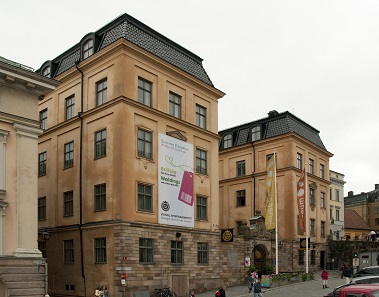by Harald Nilsson
translated by Christina Schlögl
January 12, 2017 – The Royal Coin Cabinet in Stockholm is the oldest museum in Sweden. It was founded as early as the 1570s. Since 1997, the Coin Cabinet has been located in a representative building in the centre of Stockholm’s old town. However it is now at the risk of being closed. The exhibitions are already taken down. The aim is to relocate the Coin Cabinet to a probably significantly smaller venue in the direct vicinity of the Swedish History Museum. This new venue has yet to be converted and secured.
The Sveriges ekonomiska museum from the outside. Photo: Sören Eriksson / CC BY-SA 3.0
The Royal Coin Cabinet in Stockholm has reached international prominence mostly due to its unfinished project to cataloguing the enormous amounts of Viking coin finds in Sweden. The project has been co-funded by German and English research foundations. It is associated with established names such as Peter Berghaus, Gert and Vera Hatz in Germany as well as Michael Dolley and Mark Blackburn in Great Britain. Hundreds of thousands of Arabic, German and English coins are known from these findings, the majority of which are kept at the Stockholm Museum thanks to a findings legislation that dates back to the 17th century. The installment of an independent numismatic museum goes back to the intense efforts of Brita Malmer, who headed the Viking project for many years. The museum has been structurally adjusted to meet the requirements of such an extensive coin collection, which are not only Swedish cultural heritage but also cultural heritage of Germany, the United Kingdom and the Arabic countries.
Thus far, the history of money around the world has been on display in Stockholm on three floors. Special attention has been given to treasure finds, the history of medal minting and the evolution of saving. The museum’s educational department was provided with an exhibition for children, which did not only explain the phenomenon of inflation via a declining number of sweets in a child-orientated manner, but which also featured an almost authentic pirate ship with its own treasure. This room has already been torn down and the impressive medal collection is currently suffering the same fate.
Although the contracts for spaces of the Royal Coin Cabinet have already been terminated, it is still unknown, where and how the enormous collection of more than 500,000 objects of the rooms of the Swedish Historic Museum is supposed to be transferred to. Not to mention the corresponding offices which should be located in close proximity to the objects for efficient processing and publication.
The demolition of the Royal Coin Cabinet, which entails tearing down exhibition rooms as well as strong rooms, constitutes a tremendous destruction of capital. However, losing the museum might be an even bigger issue. It is the loss of another museum of numismatics, of which there are far too few as it is. Surely this will only be detrimental to the already shaken museum landscape of Stockholm, where tourists will soon no longer be able to view the Royal coin collection in the direct proximity of the castle.
Another aspect is the most prominent numismatic library in Sweden, which is run by the Royal Swedish Academy of Letters, History and Antiquities and which is located within the Coin Cabinet. The future location of the library is still unknown. It only seems certain that, just like the other collection objects, the library will be inaccessible for several years during its relocation. This will massively compromise numismatic research in Sweden.
According to the official statements, increasing rents for the Stockholm museums are the cause of this far-reaching development. Although one must know that there is an intricate but ill-conceived zero sum game at play with this type of letting in Sweden. The state museums mostly rent their spaces from state building administrations who adjust their rents according to a seemingly market-conform rent-index. In view of the rising rents, the financing of the museums thus becomes increasingly expensive. At least that is what the official statements say. At a closer look, one will of course find that the museum rents go back to the state anyway and that the rising rents are merely a convenient and politically harmless argument to justify a massive change (i.e. decimation) of the museum landscape.
In the end, the Swedish Ministry of Culture is responsible for this development. If you would like to point out the importance of the Royal Coin Cabinet not only for the Swedish but also for international cultural heritage, you can reach them via the email address kulturdepartementet.registrator@regeringskansliet.se.
According to Swedish law, due to the Swedish principle of public access to official Records, all correspondences to the administrative bodies have to be registered and made accessible to the public. That way, both the public and journalists can have a look at these letters, which is a clear advantage in this situation.
The website of the museum is still online, but no one knows for how long.
There is an extensive article on the museum on Wikipedia.
Tripadvisor rates the museum with 4 out of 5 points.
Comments go from “don’t miss it!” to “great little museum” or “a coin lover’s heaven“.
There are Swedish videos on the evolution of money on Youtube that start with a panoramic view of the museum.





